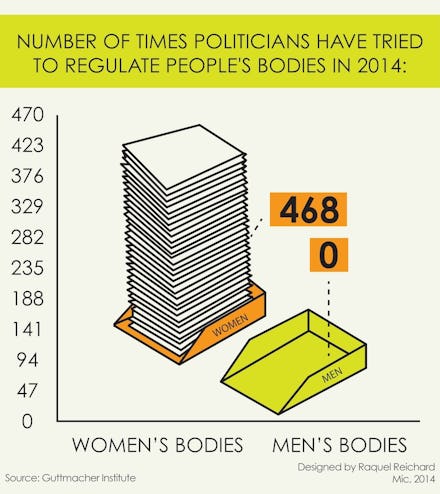One Chart Shows All the Times Politicians Decided to Regulate Men's Bodies in 2014

We're only halfway through 2014, and state legislators have already introduced a whopping 468 restrictions intended to limit, control or otherwise regulate women's reproductive rights.
How many comparable bills have been introduced to regulate men's reproductive health care during this period? Zero.
Something's very wrong with this picture.
Image Credit: Mic/Raquel Reichard
The Guttmacher Institute, a nearly 50-year-old nonprofit dedicated to advancing reproductive health and rights, compiled the figures over the course of comprehensive research leading up to its recently released midyear report.
Obviously the reproductive needs and concerns of men and women are different, but that's not the point. The fact that half of the population is subject to such a disproportionate array of potential legislation surrounding their bodies and related personal choices is nothing short of outrageous.
As Sen. Nina Turner (D-Ohio) passionately declared at a pro-choice rally last year (at which point 700 similar bills had been introduced), "This isn't about one bill or about one state. It is about the unrelenting obsession with regulating a woman's womb. ... If [representatives] want to make intimately personal decisions about women's lives and their anatomy, I strongly urge them to go to medical school. But until then, stay out of a woman's womb!"
This isn't to say that all of these attempts have been successful, of course. Of the 468 proposed restrictions, 21, covering 13 states, have been adopted thus far. But much like the Supreme Court's Hobby Lobby ruling in June, the impact of these 21 bills could be felt across the country. In Virginia, for example, genetic counselors can now "refuse to provide any information to patients because of their personal religious or moral beliefs." In Arizona, helping a minor obtain an abortion without parental consent has been classified as a crime. And in Kansas, counseling materials no longer state that they are "objective, nonjudgmental and scientifically accurate."
When asked whether or not there was any comparable recent legislation meant to regulate men's sexual activity, Guttmacher's Elizabeth Nash told Mic, "I'm desperately trying to think of something male-specific that would be bad restrictive. Not so much. Usually when we're talking about men and reproductive health, we're talking about getting them access to condoms or STI care, and no one is trying to restrict access to that stuff."
The idea of restricting men's reproductive health care is so foreign that you may be wondering what doing so would even look like. Back in 2012, six female, Democratic lawmakers thought the same thing, and actually proposed some tongue-in-cheek legislation meant to highlight the injustice of such intense regulation of women's reproductive rights. The doomed-from-the-start bills would do things like prohibit vasectomies:
"Thousands of children are deprived of birth in this state every year because of the lack of state regulation over vasectomies."
Force men to see a sex therapist before getting a prescription for erectile dysfunction:
"The physician shall ensure that the sessions include information on nonpharmaceutical treatments for erectile dysfunction, including sexual counseling and resources for patients to pursue celibacy as a viable lifestyle choice."
And, evoking an argument once port forth by Legally Blonde's Elle Woods, limit where men can ejaculate:
"Any action in which a man ejaculates or otherwise deposits semen anywhere but in a woman's vagina shall be interpreted and construed as an action against an unborn child."
It all sounds a bit silly, because why would anyone restrict access to things that are simply part of normal reproductive health?
Except access to contraception and abortion are just that, too. The benefits of family planning are undeniably far-reaching: According to the World Health Organization, it can reduce the rate of pregnancy-related health risks, infant mortality, teen motherhood and population growth. It's an essential component of gender equality too, as granting women the ability to decide when to have children can empower them to continue their education and participate more fully in professional life.
It's perhaps heartening to know that the number of enacted restrictions is significantly lower than it was at this time last year (by mid-2013, there were already 41). Guttmacher posits that this discrepancy isn't due to shifting attitudes, however, but rather to typical trend cycles and increasing focus on other issues like minimum wage and the common core, "perhaps limiting legislative attention to abortion."
There is a silver lining in the handful of states that have actually begun to improve access to vital sexual health services. Connecticut, New Mexico and South Carolina have "expanded requirements for sex education," for example, and New Hampshire adopted a law that allows for 25-foot buffer zones around abortion clinics. Unfortunately, the same group that successfully argued against 35-foot buffer zones in Massachusetts has now turned its sights northward.
It's clear this battle is far from over. Many of these laws are being challenged by groups intent on protecting a woman's constitutional right to choose, and rightfully so. We need to keep fighting to ensure that women have safe, affordable access to the reproductive health care they need — just like everyone else.